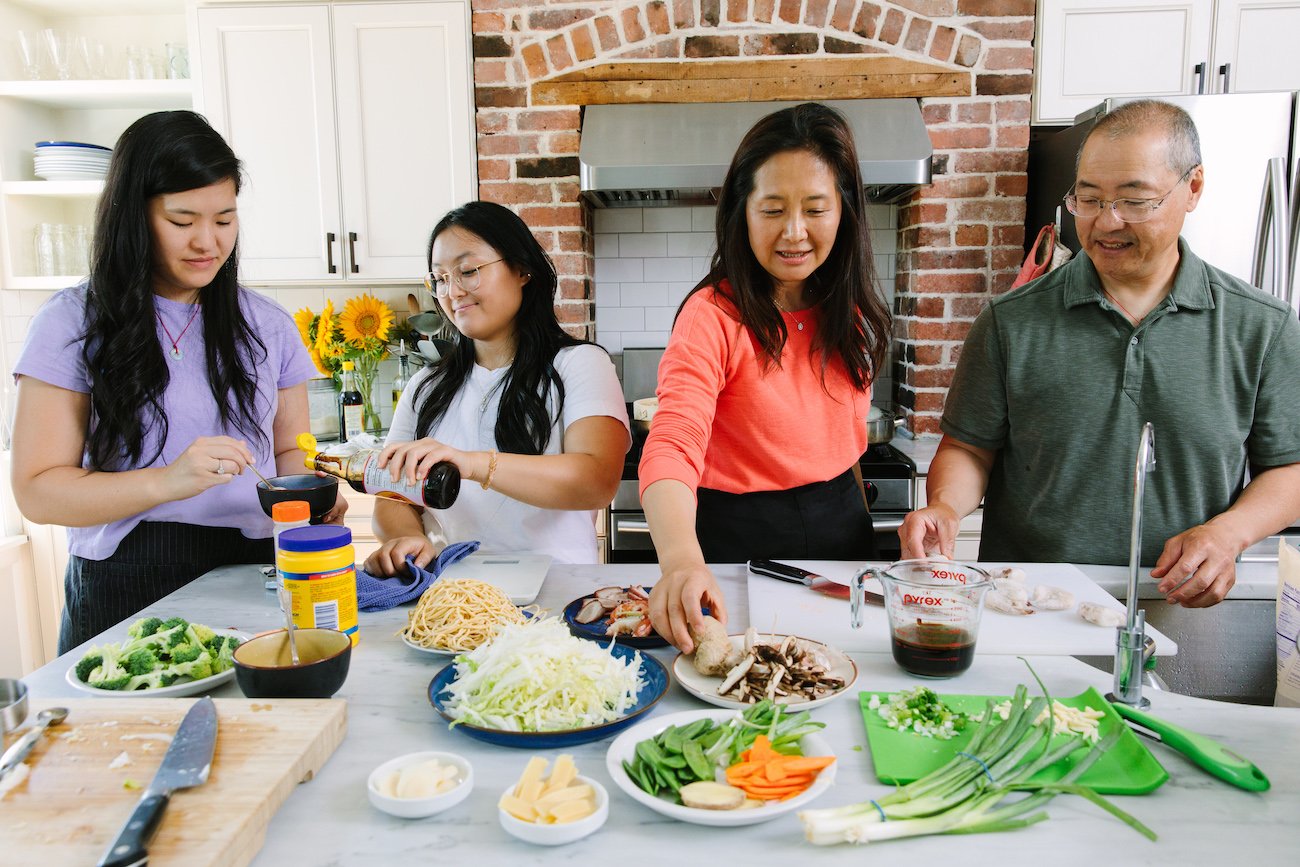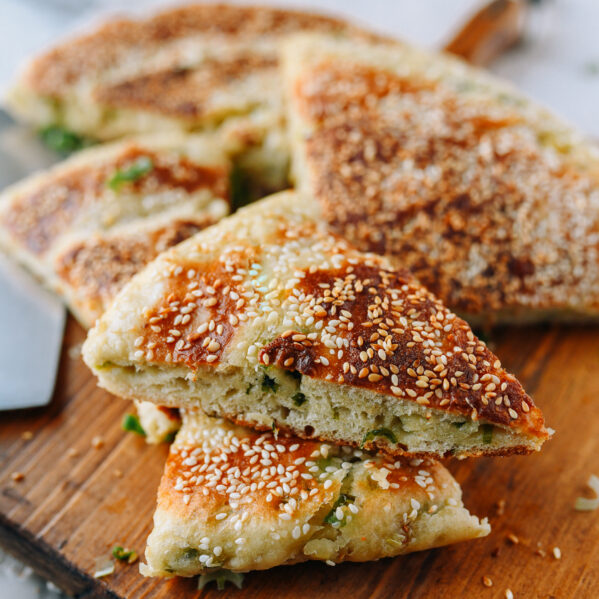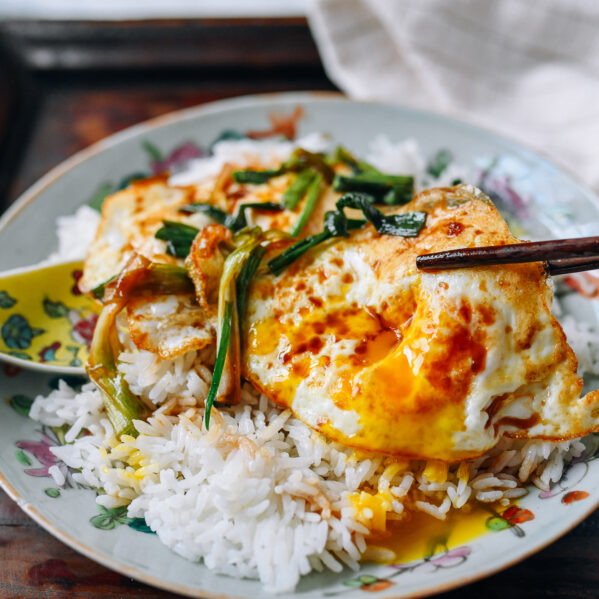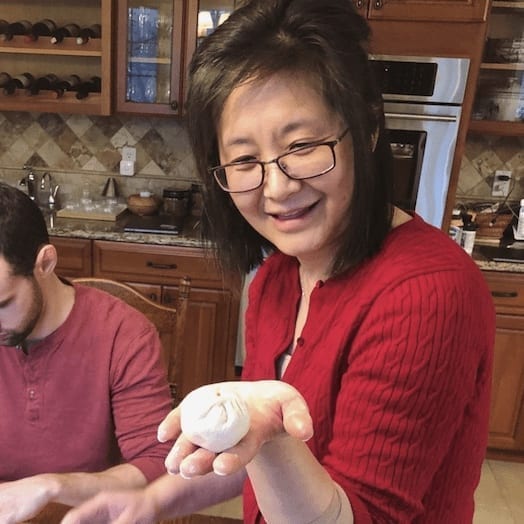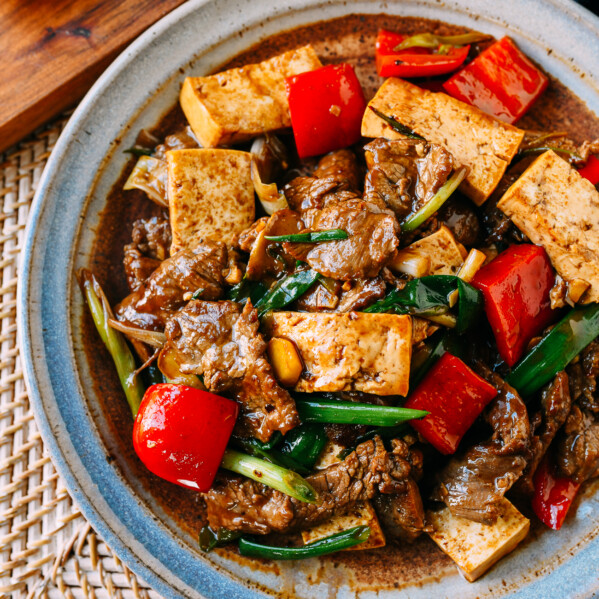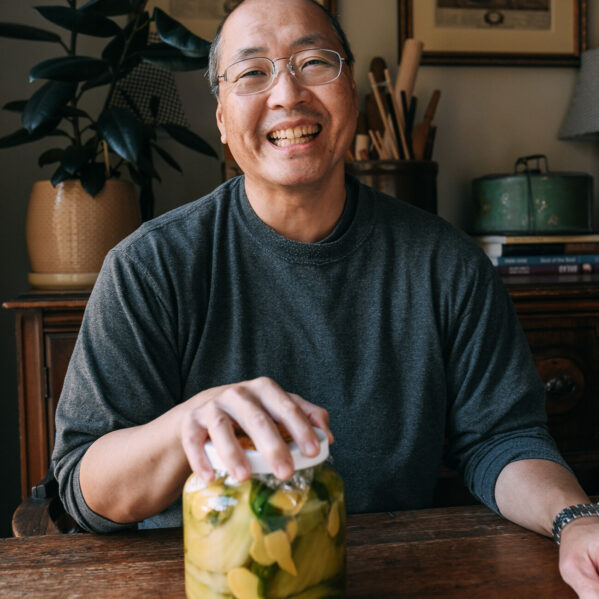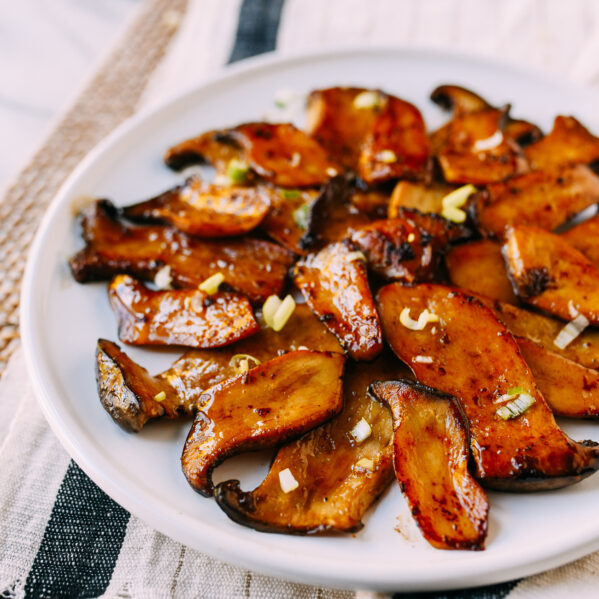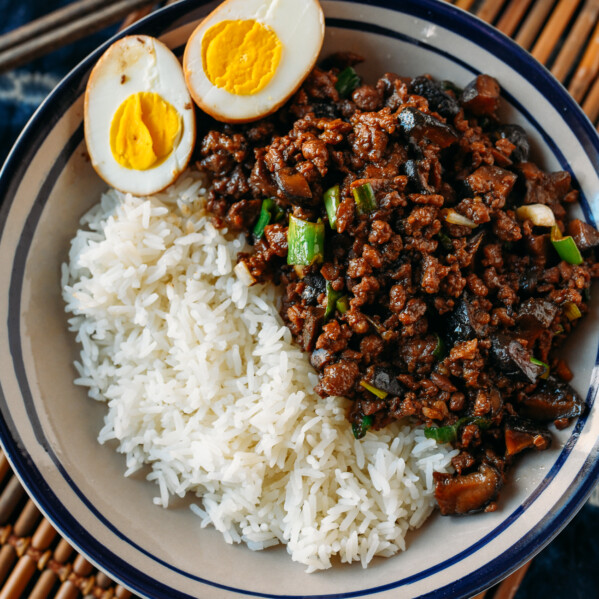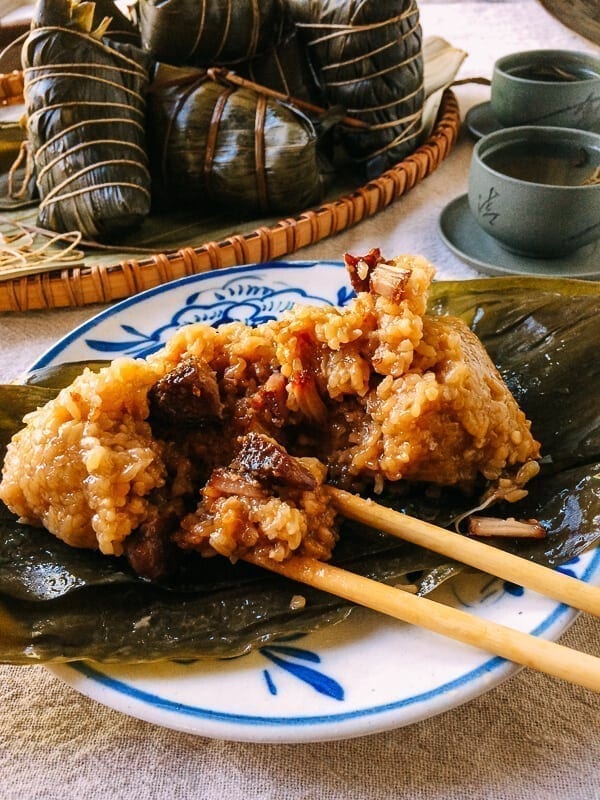
Zongzi, or sticky rice dumplings, are almost like a Chinese version of the tamale––sticky rice is wrapped in bamboo leaves with other fillings, and steamed.
I’ll be using both the Chinese word “zongzi” and the term “sticky rice dumpling” interchangeably in this article. (Just know that while “sticky rice dumpling” is a common translation, it’s not the most accurate one—it’s more of a sticky rice parcel).
While enjoyed mostly during the 2000-year-old Chinese Duan Wu Festival (Duānwǔ Jié 端午节) or Dragon Boat Festival, zongzi can be enjoyed any time of the year.
If you’ve ever had any sticky rice dumpling or parcel, you know that at the end of the day, these delicious packets of sticky rice and pork are well worth the effort to hunt them down or make them yourself at home!
What Makes Shanghai-Style Zongzi Different?
The major difference between Shanghai Style Pork Zongzi (上海肉粽子) and Cantonese Style Pork Zongzi is its use of both light soy sauce and dark soy sauce.
Like the famous Shanghai Braised Pork Belly, when you have the right combination of light soy sauce, dark soy sauce, sugar and Shaoxing wine, just a few ingredients can produce an extraordinary flavor that stands the test of time.
Notes on Ingredients
Ok, let’s get into the logistics of making a good Shanghai-Style Pork Zongzi, with more details on some of the ingredients.
Soy Sauce
How much soy sauce you use is just as important as the brand you use, as the flavor and levels of saltiness really do differ between brands. I like to use Pearl River Bridge.
Just so you know before you buy, Pearl River Bridge’s light soy sauce barely adds any color, whereas dark soy sauce adds an intensely rich color. Both are similarly salty.
Use your preferred brands, but be mindful of their saltiness, since this recipe requires a lot of both light and dark soy sauce. It’s best to taste them beforehand to get a sense!
Pork Fat
Another key component for this Shanghai-Style Pork Zongzi is the pork fat, i.e. pork belly. Pork fat does wonders for the glutinous rice and I promise, it will not taste greasy or fatty at all–everything just melts in your mouth.
I know the next question will be about substitutions. I tested this recipe with pork belly and pork shoulder, and with a small piece of pork belly and pork shoulder combined to get a happy medium.
The results weren’t “happy enough” though, so I suggest using only pork belly, but try to find a lean cut that has the perfect meat to fat ratio. If you insist on using leaner pork, you can use pork shoulder.
Chestnuts (Optional)
Most store-bought Shanghai Style Pork Zongzi have just glutinous rice and pork. If you like, you can toss in one or two ready-to-eat roasted chestnuts per sticky rice dumpling, but in general, I don’t like to add too many add-ons or over-spice the meat, as it takes away from the pure, traditional flavors!
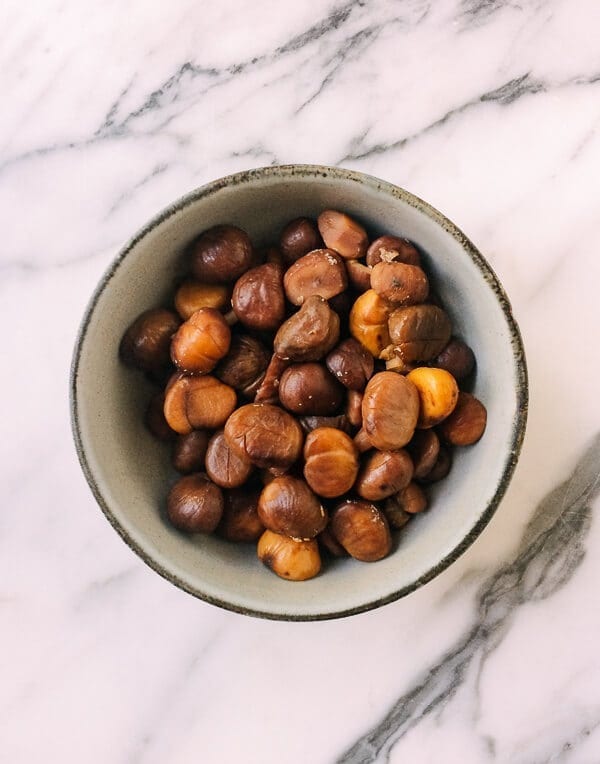
A Note On Cooking
Lastly, you should know that cooking sticky rice dumplings requires a long time. It’s a commitment to make them, but the actual cooking time is quite long (though it does vary on the sticky rice dumpling size and how tightly you wrap the twine).
After making zongzi for a few years, I’ve learned that there is no need to overstuff the sticky rice dumpling as rice needs room to expand during cooking. Nor is there a need to wrap the twine too tightly for fear that they’ll fall apart.
Once all the openings in the bamboo leaves are well tucked and concealed, the twine will go around naturally, and there shouldn’t be any excessive tension or visible bulges. You can probably track my skill level of making zongzi over the years through our recipe photos! Ha!
These tips will make your life easier and reduce the cooking time. All told, I cooked my large batch of sticky rice dumplings for 4½ hours and left them in the pot without opening the lid overnight.
This recipe makes 30-35 pieces. I know, it’s a lot. But trust me, when you go through all the prep, you want a lot at the end! Plus, I always gift some to my mother and her friends, and I’m planning on dropping some off for my cousin and her family. You can also freeze them after cooking and reheat one or two whenever you’re hungry.
Feel free to halve the recipe if you want a smaller batch. All the cooking times will remain the same.
Can You Use a Pressure Cooker/Instant Pot?
If you want to cook them in a pressure cooker or Instant Pot, you will need about an hour with the maximum water level allowed. Be sure to adjust the water level accordingly. You’ll also have to make them in batches based on the size of your Instant Pot.
We have full, detailed instructions in our post on How to Cook Zongzi in an Instant Pot.
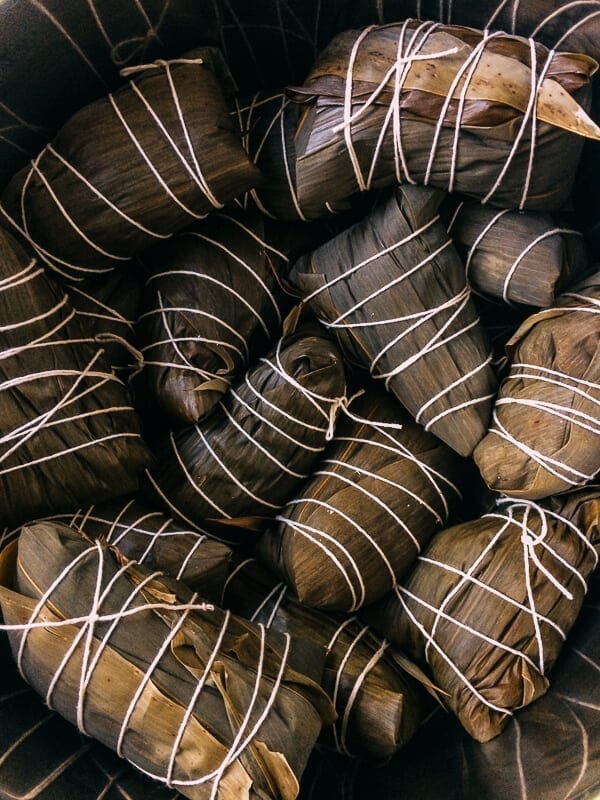
To assemble the zongzi, you’ll need:
- 75-80 dried bamboo leaves (2 to 3 leaves per zongzi)
- 5 pounds uncooked short grain sticky rice (also called glutinous rice, or “sweet rice”)
- 3 pounds pork belly (and/or pork shoulder)
- Kitchen twine to tie the zongzi
For the pork marinade, you’ll need:
- ¼ cup light soy sauce
- 3 tablespoons dark soy sauce
- 4 teaspoons salt
- 5 tablespoons sugar
- 3 tablespoons Shaoxing wine
- 1 teaspoon ground white pepper
- 1 teaspoon five-spice powder
- ¼ cup water (you may not need this, but if you do, you’ll add 2 tablespoons at a time)
For the rice marinade, you’ll need:
- 5 tablespoons light soy sauce
- 5 tablespoons dark soy sauce
- 1½ tablespoons sugar
- 2½ tablespoons salt
The night before:
Soak the zongzi leaves by weighing them down in a bowl of water with a heavy object. They should be completely submerged.
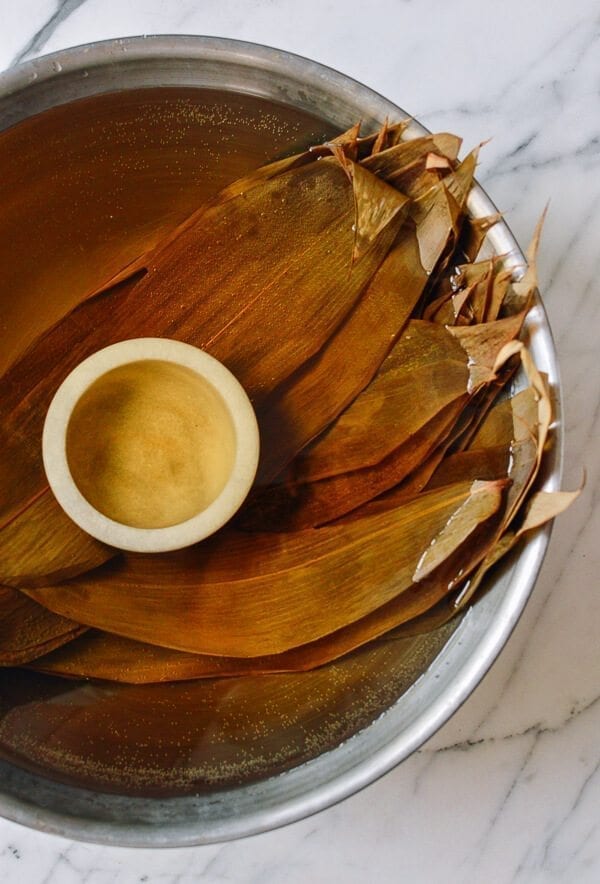
In a large container, soak the glutinous rice in water, making sure the water level is 3-4 inches above the rice, as it will expand considerably as it soaks.
Cut the pork belly into 1-inch x 2-inch chunks. Combine the pork with all the marinade ingredients except the water (the light soy sauce, dark soy sauce, salt, sugar, Shaoxing wine, white pepper, and five-spice powder), and mix everything well. It may seem like a lot of salt, but the rice will absorb the saltiness during the cooking process. If there is no visible liquid after mixing, add water, 2 tablespoons at a time. Pork can soak up a lot of liquid and the liquid will help to keep it moist. The pork marinade should be wet, but without too much liquid pooling at the bottom.
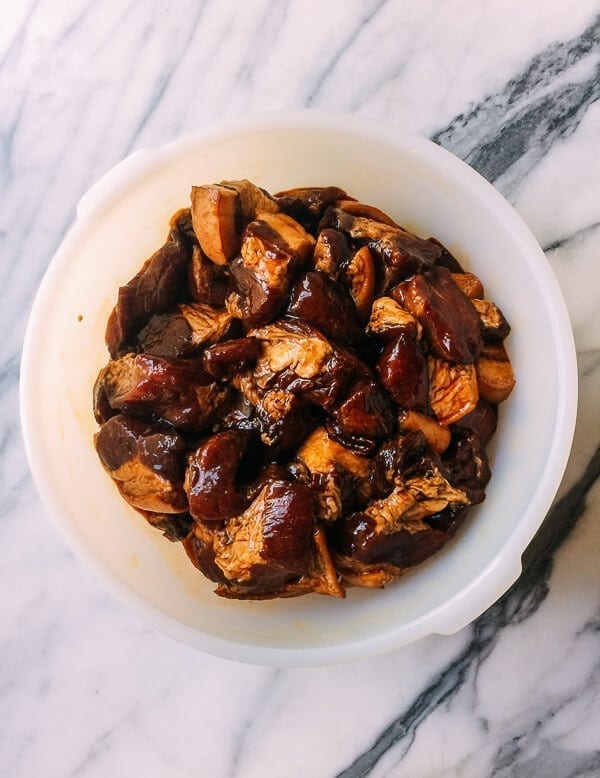
The next day:
Completely drain the rice using a fine-meshed colander or sieve. Mix in the rice marinade ingredients (the light soy sauce, dark soy sauce, sugar, and salt), and mix everything well. Set aside, and marinate for about 30 minutes.
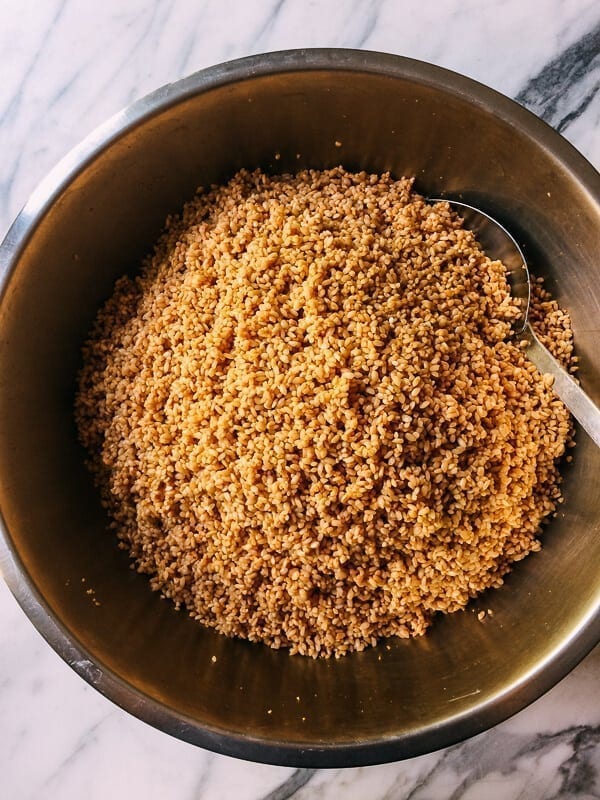
In the meantime, wash each leaf front and back with a soft cloth, and rinse. Transfer them to a bowl of fresh water until you’re ready to wrap your sticky rice dumplings so they don’t dry out.
Lay out all the components: the pork, the rice, zongzi leaves, and kitchen twine. Now you’re ready to start wrapping zongzi! Follow the step-by-step photos on how to wrap them here, but here are a few tips for success:
- You must cut away at least ½” off the bottom of––that section is too coarse and difficult to work with.
- Make sure the kitchen twine is high quality. To prevent it from breaking, you can also soak it in a bowl of water. It’s also best to tie one end of the twine to an anchor point (like your kitchen sink) because you’ll only have one hand to tie the zongzi. The other hand will be holding the zongzi together. In my case, I just use my teeth to hold one end of the twine. Made with love, right? :)
- If leaves rip anywhere during the wrapping process, you’ll need to start over and discard the ripped leaf. That’s why I call for more leaves than are technically needed. Some of the leaves are bound to get ripped!
- There will be visible sauce at the bottom of the rice when you get to the end, simply drain it out once you start to see this, as you don’t want any excess liquid in the zongzi.
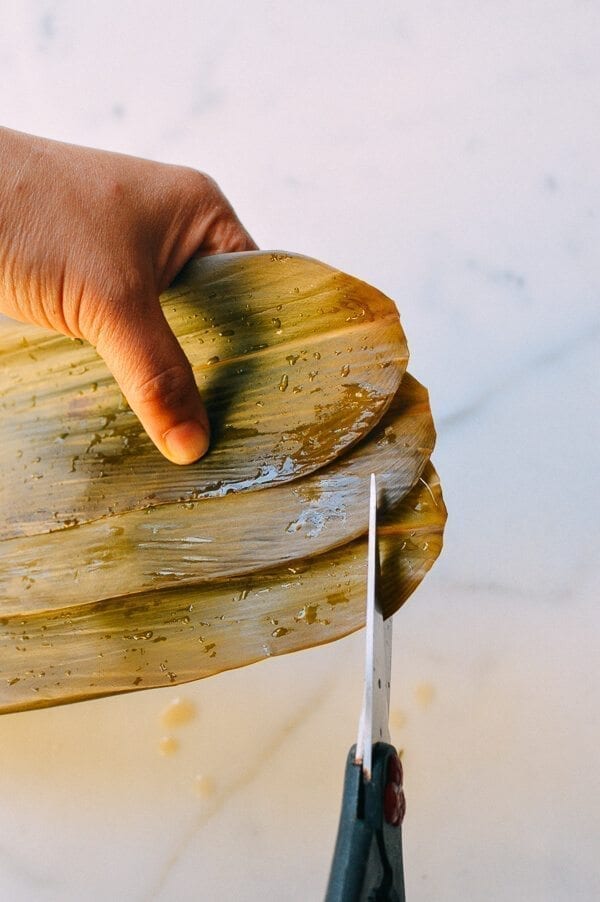
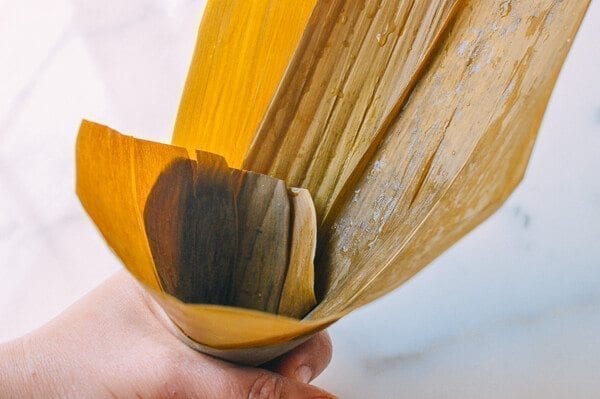
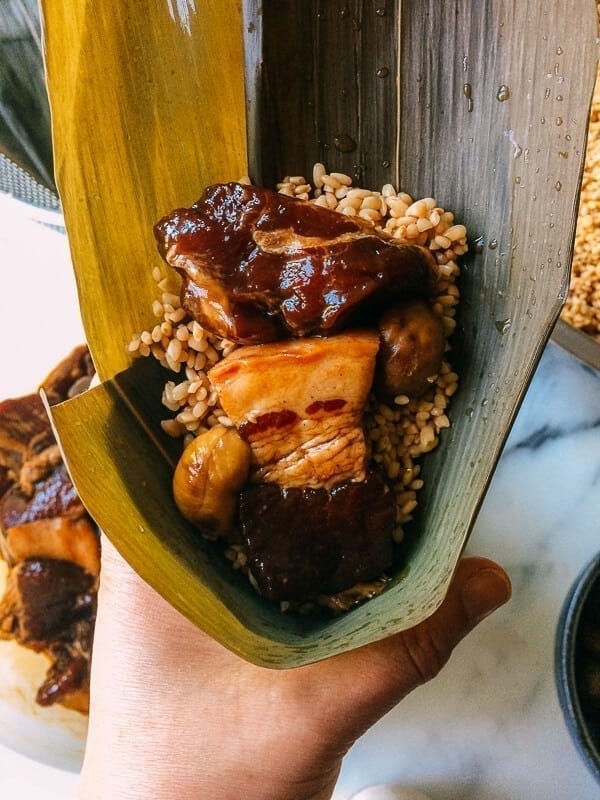
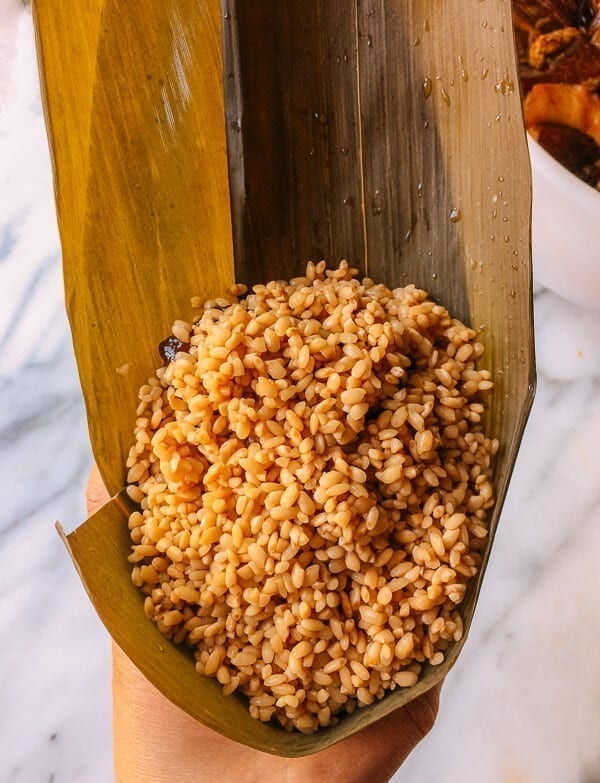
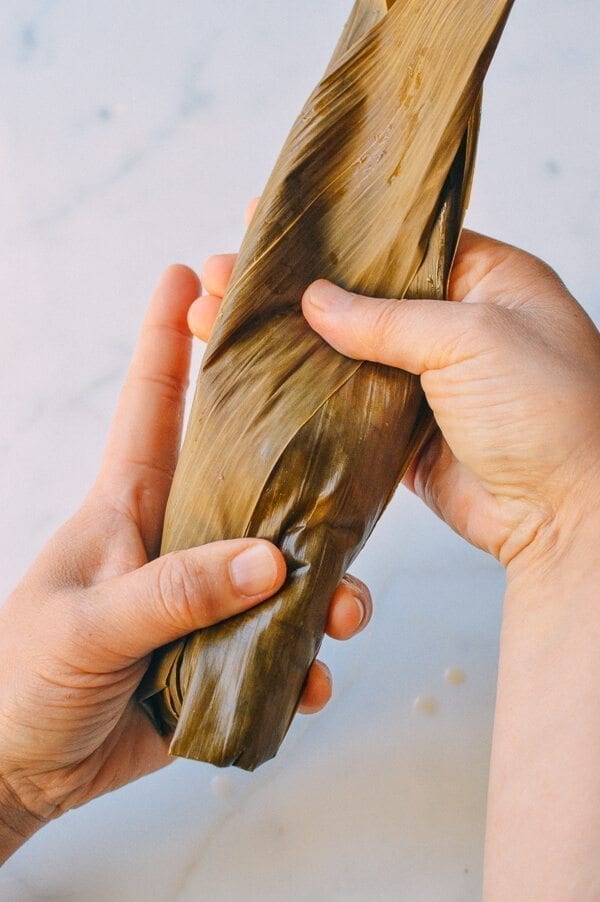
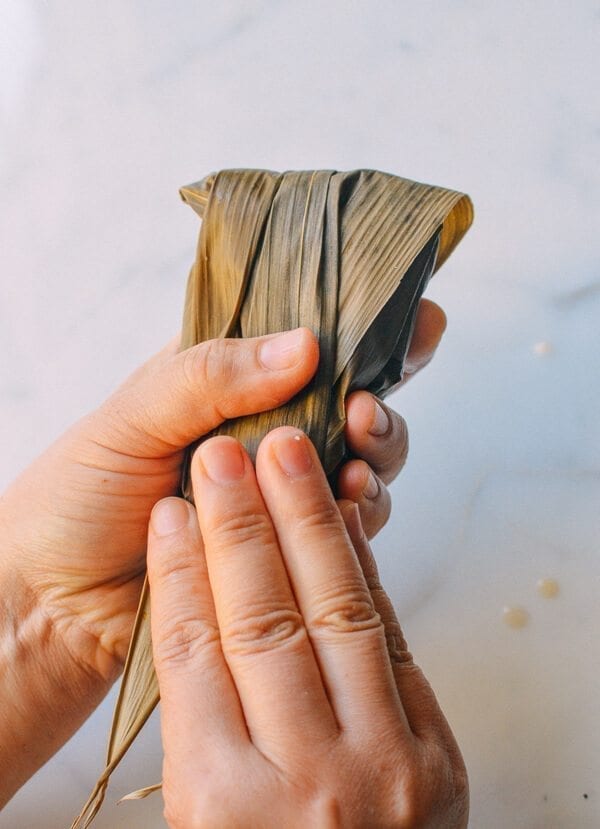
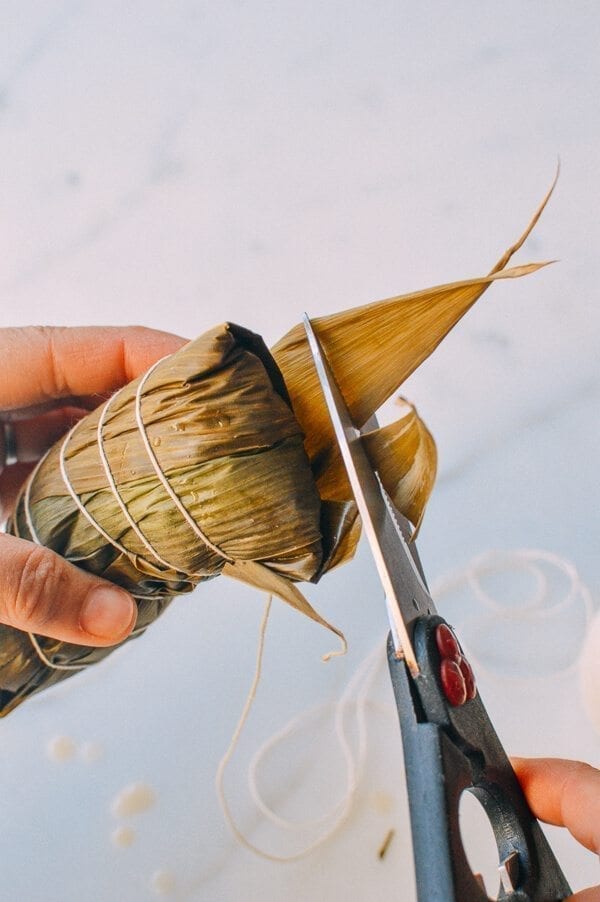
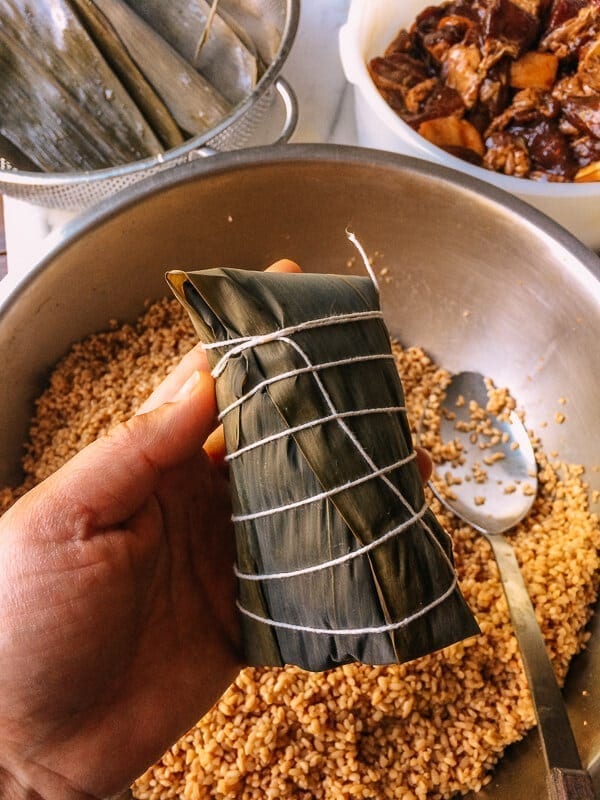
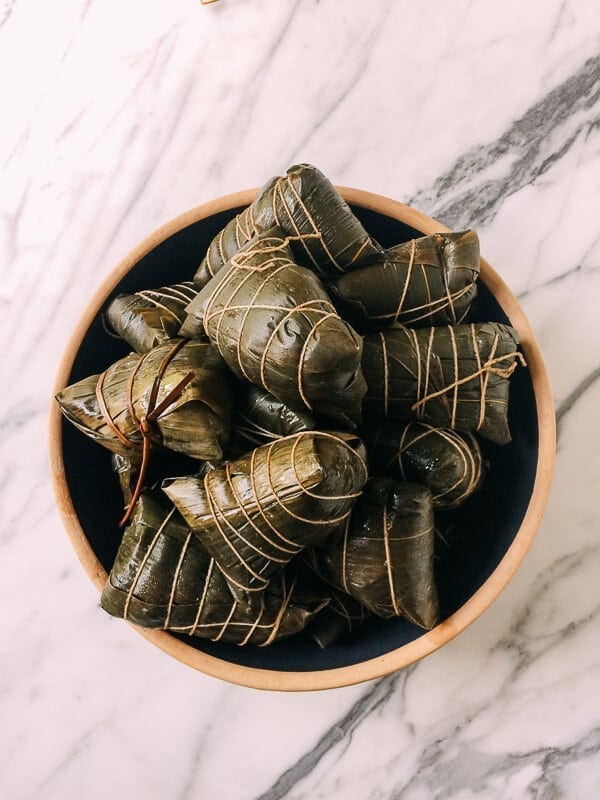
To cook the zongzi…
Neatly and tightly nest all the zongzi in a large soup pot. Ideally, there will be no visible gaps. If necessary, put a large heatproof plate directly on top of the zongzi to weigh them down. Fill the pot with cold water until they are completely submerged.
Place the pot on the stove over high heat. Once the water boils, turn the heat to medium-low, and let it simmer for at least 4-5 hours. The water should be “moving” at a light simmer; definitely not boiling. Check the pot fairly often to make sure the zongzi are always submerged in water. Add only boiling water so the water temperature never gets too low.
Note: You can cook them faster using an Instant Pot (click here for instructions). It will take just 90 minutes, as opposed to several hours.
To serve the zongzi…
For savory sticky rice dumplings, it’s best to eat them when they’re hot or at least warm. No condiments necessary, but sometimes Kaitlin likes to add chili oil to hers. She is weird, but you can be weird too if you want. As a side note, if you are eating sweet zongzi, they are actually best at room temperature or slightly chilled. The glutinous rice becomes even more delightfully chewy when chilled!
To reheat the zongzi…
Boil them in water for at least 15 minutes if they are cold/refrigerated, and for 30 minutes if they are frozen.
To store the zongzi…
You can refrigerate them for up to a week. If you need more time to eat them, it’s best to freeze them in a heavy-duty resealable bag.
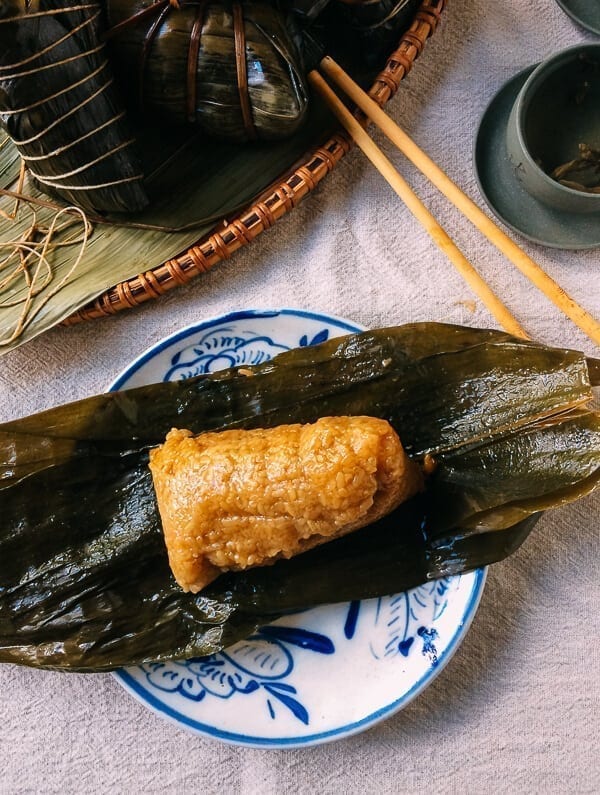
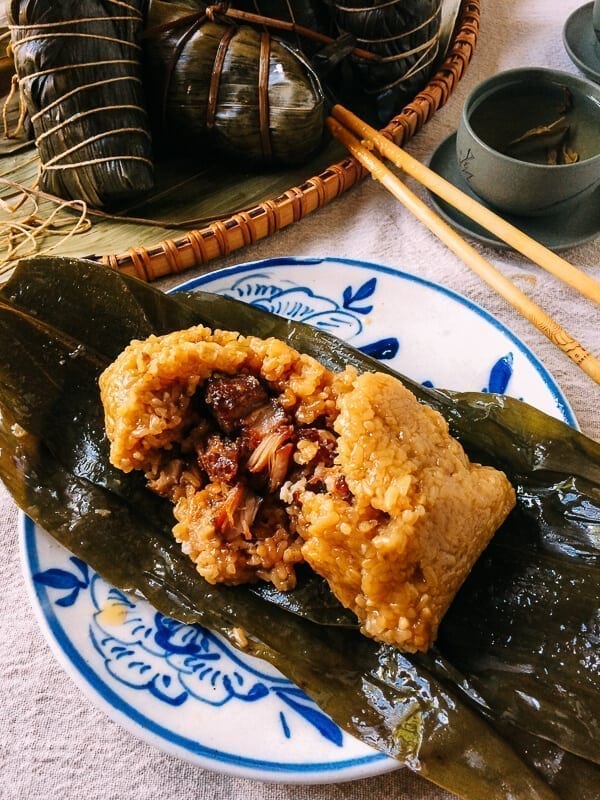
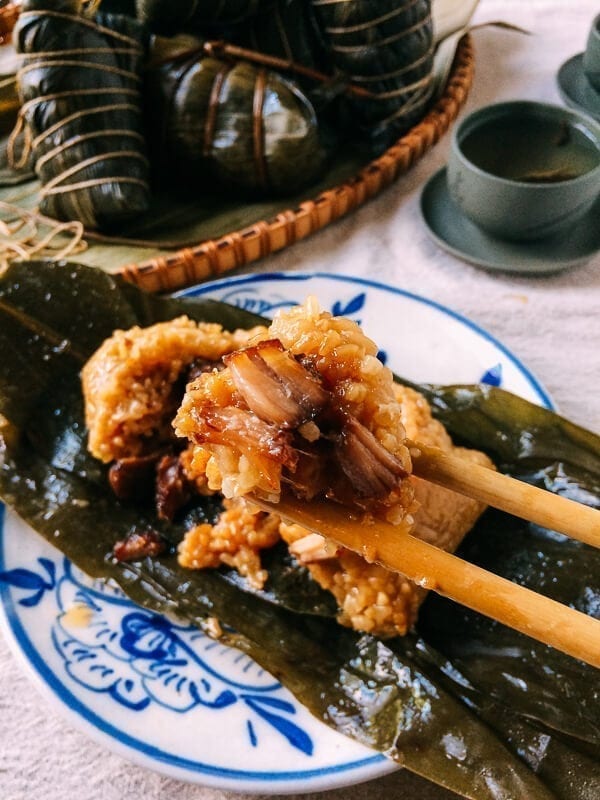
See our Shanghai travel post during Duan Wu Chinese holiday in China –China’s Dragon Boat Festival & Rice Dumplings Galore and try our other favorite Zongzi sticky rice dumpling recipes!
Happy Duanwu Festival / Duānwǔ Jié (端午节) / Dragon Boat Festival!
Looking for more authentic recipes? Subscribe to our email list and be sure to follow us on Pinterest, Facebook, Instagram, and Youtube!
Recipe
Shanghai Style Pork Zongzi (Sticky Rice Dumplings)
Ingredients
To assemble the zongzi, you’ll need:
- 75-80 dried bamboo leaves (2 to 3 leaves per zongzi)
- 5 pounds uncooked short grain sticky rice (also called glutinous rice, or "sweet rice")
- 3 pounds pork belly (and/or pork shoulder)
- Kitchen twine to tie the zongzi
For the pork marinade, you’ll need:
- ¼ cup light soy sauce
- 3 tablespoons dark soy sauce
- 4 teaspoons salt
- 5 tablespoons sugar
- 3 tablespoons Shaoxing wine
- 1 teaspoon white pepper
- 1 teaspoon five spice powder
- ¼ cup water (you may not need this, but if you do, you’ll add 2 tablespoons at a time)
For the rice marinade, you’ll need:
- 5 tablespoons light soy sauce
- 5 tablespoons dark soy sauce
- 1½ tablespoons sugar
- 2½ tablespoons salt
Instructions
- The night before: Soak the zongzi leaves by weighing them down in a bowl of water with a heavy object. They should be completely submerged. In a large container, soak the glutinous rice in water, making sure the water level is 3-4 inches above the rice, as it will expand considerably as it soaks. Cut the pork belly into 1-inch x 2-inch chunks. Combine the pork with all the marinade ingredients except the water (the light soy sauce, dark soy sauce, salt, sugar, Shaoxing wine, white pepper, and five-spice powder), and mix everything well. It may seem like a lot of salt, but the rice will absorb the saltiness during the cooking process. If there is no visible liquid after mixing, add water, 2 tablespoons at a time. Pork can soak up a lot of liquid and the liquid will help to keep it moist. The pork marinade should be wet, but without too much liquid pooling at the bottom.
- The next day: Completely drain the rice using a fine-meshed colander or sieve. Mix in the rice marinade ingredients (the light soy sauce, dark soy sauce, sugar, and salt), and mix everything well. Set aside, and marinate for about 30 minutes. In the meantime, wash each leaf front and back with a soft cloth, and rinse. Transfer them to a bowl of fresh water until you’re ready to wrap the zongzi so they don’t dry out. Lay out all the components: the pork, the rice, zongzi leaves, and kitchen twine. Now you’re ready to start wrapping zongzi! Follow the step-by-step photos on how to wrap them. There will be visible sauce at the bottom of the rice when you get to the end, simply drain it out once you start to see this, as you don’t want any excess liquid in the zongzi.
- To cook the zongzi, neatly and tightly nest all the zongzi in a large soup pot. Ideally, there will be no visible gaps. If necessary, put a large heatproof plate directly on top of the zongzi to weigh them down. Fill the pot with cold water until they are completely submerged. Place the pot on the stove over high heat. Once the water boils, turn the heat to medium-low, and let it simmer for at least 4-5 hours. The water should be “moving” at a light simmer; definitely not boiling. Check the pot fairly often to make sure the zongzi are always submerged in water. Add only boiling water so the water temperature never gets too low.





